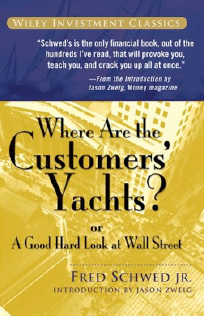Where Are the Customers’ Yachts? – Redux

Where are they, indeed? If you haven’t read the book, do yourself a favor and get a hold of a copy. First published in 1940, it is informative, well written, and witty. And still very relevant.
The point here is not to languidly blame anyone, or to say that people who could afford yachts yesterday can no longer do so (though certainly a few may very well not). In a more realistic context, the question of where the customers’ “yachts” have gone can be answered by looking at where the returns from their investments have gone. Because the net return to the investor is only part of the total return any investment yields. And it’s in this gap that you may find a few yachts indeed.
How so? If you take any investment that is represented by an index, or even a single security, you will find easily its price and periodically some figures that will tell you how well or badly that investment has done. If you buy that investment (an index through an ETF or a single security, or a mutual fund which purports to deliver better results than the index) and you do the math on your achieved returns, in most cases you will discover a large difference with the “pure” published figures. The size of these differences will depend on your custody and trading charges (all investments), on the frequency of your trading and the timing of the same (depends), and on additional fees which are charged on the investment vehicle (mostly mutual funds).
There are a few studies out there that explicitly calculate what the size of the indicated differential has been in the past, and it amounts anywhere from a third to a half of the total return of the “uncontaminated” index. Not peanuts, but yachts, in other words.
A more insidious threat to your net returns can be exemplified in a short story. A while ago I used to know – technically, work for – a wiry be-spectacled fellow who was fond of pompously proclaiming “in the vast realm of the financial world there is always something that goes up a lot in any one year.” “Fantastic insight!” you might instinctively exclaim, till you stop and think and realise the simple truism, and associated uselessness, embedded in this assertion. “Uselessness” from an investor’s point of view, because if you happen to be someone who sells investment ideas to his/her clients – like the wiry be-spectacled fellow – it’s not useless at all: in the cacophony of possibilities and the excitement of fertile minds, at least some of the ideas are bound to “stick”, extolling trades which generate revenues for the broker but may or may not work for the investor. Unless you have a describable and disciplined process, proposing investment moves can be a little like advising people on how to flip a coin.
Beware of the coin-flipping experts, of wiry be-spectacled fellows, and of the size of their yachts.
Photo Source: amazon.com